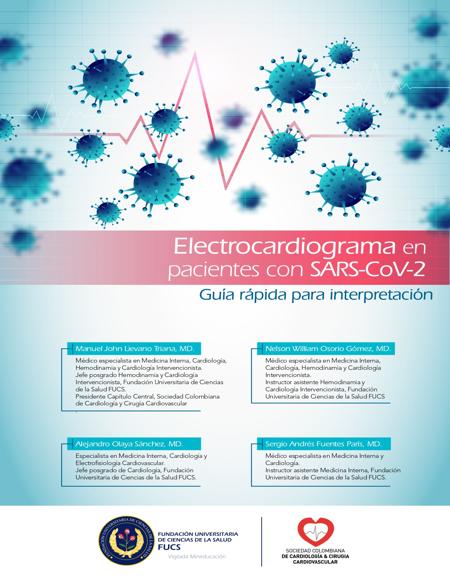A perspective on the spread of Covid-19 in Colombia by 2021
Perspectiva del COVID-19 en Colombia para el año 2021
How to Cite
Download Citation
![]()
![]()

Show authors biography
Introduction: severe acute respiratory syndrome coronavirus 2 (SARS-CoV-2) has spread rapidly worldwide, including the relative importance of various transmission routes, the role of asymptomatic and pre-symptomatic infection and the susceptibility and transmissibility among specific age groups. Objective: to present a perspective on the spread of COVID-19 in Colombia by 2021. Methodology: the ARIMA (0,1,0) model was used for predicting future data. Results: the estimated values by the end of December 2021 will be 4’973.547 infections, 4’784.987 recoveries and 110.159 deaths. Conclusion: the use of mathematical modeling have made considerable progress during the last few decades and is a very important tool to illustrate effective scenarios for infectious disease prevention and control, with the aim to further enhance monitoring of the SARS-CoV-2 and controlling its transmission rate in Colombia.
Article visits 5484 | PDF visits 2537
Downloads
- Li Q, Guan X, Wu P, Wang X, Zhou L, Tong Y, et al. Early Transmission Dynamics in Wuhan, China, of Novel Coronavirus-Infected pneumonia. N Engl J Med. 2020;382(13):1199-1207. Doi: 10.1056/NEJMoa2001316 DOI: https://doi.org/10.1056/NEJMoa2001316
- Lee CE, Wada N, Grabowski KM, Gurley E, Lessler J. The engines of SARS-CoV-2 spread. Doi: 10.1126/science.abd8755 DOI: https://doi.org/10.1126/science.abd8755
- ISCIII. Informe sobre la situación de COVID-19 en España. 2020 [Internet]. 2020 [citado 2020 noviembre 03]. Recuperado de: https://www.isciii.es/QueHacemos/Servicios/VigilanciaSaludPublicaRENAVE/EnfermedadesTransmisibles/Paginas/InformesCOVID-19.aspx
- Díaz Pinzón, JE. Precisión del pronóstico de la propagación del COVID-19 en Colombia. Repert. Med. Cir. 2020;29(Supl.1):27-33. Doi: 10.31260/RepertMedCir.01217372.1045
- Manterola, C; Santander, C; Otzen, T. Cómo valorar e interpretar un artículo sobre pronóstico. Rev Chil Cir. 2013;65(1):77-84. Doi: 10.4067/S0718-40262013000100015 DOI: https://doi.org/10.4067/S0718-40262013000100015
- Singh RK, Rani M, Bhagavathula AS, Sah R, Rodriguez-Morales AJ, Kalita H, et al. Prediction of the COVID-19 pandemic for the top 15 affected countries: Advanced Autoregressive Integrated Moving Average (ARIMA) model. JMIR Public Health Surveill. 2020;6(2):e19115. Doi: 10.2196/19115 DOI: https://doi.org/10.2196/19115
- Kucharski AJ, Russell TW, Diamond C, Liu Y, Edmunds J, Funk S, et al. Early dynamics of transmission and control of COVID-19: a mathematical modelling study. 2020;20(5):553-558. Doi: 10.1016/S1473-3099(20)30144-4 DOI: https://doi.org/10.1016/S1473-3099(20)30144-4
- Liu Y, Gayle A, Wilder-Smith A, Rocklöv J. The reproductive number of COVID-19 is higher compared to SARS coronavirus. J Travel Med. 2020;27(2):taaa021. Doi: 10.1093/jtm/taaa021 DOI: https://doi.org/10.1093/jtm/taaa021
- Pirouz B, Shaffiee Haghshenas S, Piro P. Investigating a Serious Challenge in the Sustainable Development Process: Analysis of Confirmed cases of COVID-19 (New Type of Coronavirus) Through a Binary Classification Using Artificial Intelligence and Regression Analysis. Sustainability. 2020;12(6): 2427. Doi: 10.3390/su12062427 DOI: https://doi.org/10.3390/su12062427
- Instituto Nacional de Salud. Coronavirus (COVID-2019) en Colombia [Internet]. Bogotá: Instituto Nacional de Salud; 2020. [citado 2020 noviembre 7]; Recuperado de: https://www.ins.gov.co/Noticias/Paginas/Coronavirus.aspx.
- Díaz-Pinzón JE. Simulador Applet Descartes: como didáctica de enseñanza de la función cuadrática. INNOVA Research Jornal. 2017;2(8):69-78. Doi: 10.33890/innova.v2.n8.2017.256 DOI: https://doi.org/10.33890/innova.v2.n8.2017.256
- De la fuente S. Modelo ARIMA (p, d, q) [Internet]. 2020 [citado 2020 noviembre 7]; Disponible en: http://www.estadistica.net/ECONOMETRIA/SERIES-TEMPORALES/modelo-arima.pdf
- Calvo D. Análisis de series temporales en R. ARIMA. 2018 [Internet]. [citado 2020 noviembre 7]; Disponible en: https://www.diegocalvo.es/analisis-de-series-temporales-en-r-arima/
- Maté, C. Modelos ARIMA. 2012 [Internet]. [citado 2020 noviembre 7]; Recuperado de: https://es2.slideshare.net/juan_churqui/modelo-arima-14236175?from_action=save
- Quintero Rivera JJ. El Efecto del COVID-19 en la Economía y la Educación: Estrategias para la Educación Virtual de Colombia. Revista Scientific. 2020;5(17):280-291. Doi: 10.29394/Scientific.issn.2542-2987.2020.5.17.15.280-291 DOI: https://doi.org/10.29394/Scientific.issn.2542-2987.2020.5.17.15.280-291
- Díaz-Pinzón JE. Formación de Docentes en el Uso y Apropiación de las TIC. Innova Research Journal. 2017;2(9): 18-25. Doi: 10.33890/innova.v2.n9.2017.257 DOI: https://doi.org/10.33890/innova.v2.n9.2017.257
- Díaz-Pinzón JE. Precisión del pronóstico de la propagación del COVID-19 en Colombia. Repert Med Cir. 2020;29(Núm. Supl.1):27-33. Doi: 10.31260/RepertMedCir.01217372.1045 DOI: https://doi.org/10.31260/RepertMedCir.01217372.1045
- Díaz-Pinzón JE. Uso de modelo predictivo para la dinámica de transmisión del COVID-19 en Colombia. Repert Med Cir. 2020;29(Núm. Supl.1):34-44. Doi: 10.31260/RepertMedCir.01217372.1056 DOI: https://doi.org/10.31260/RepertMedCir.01217372.1056












